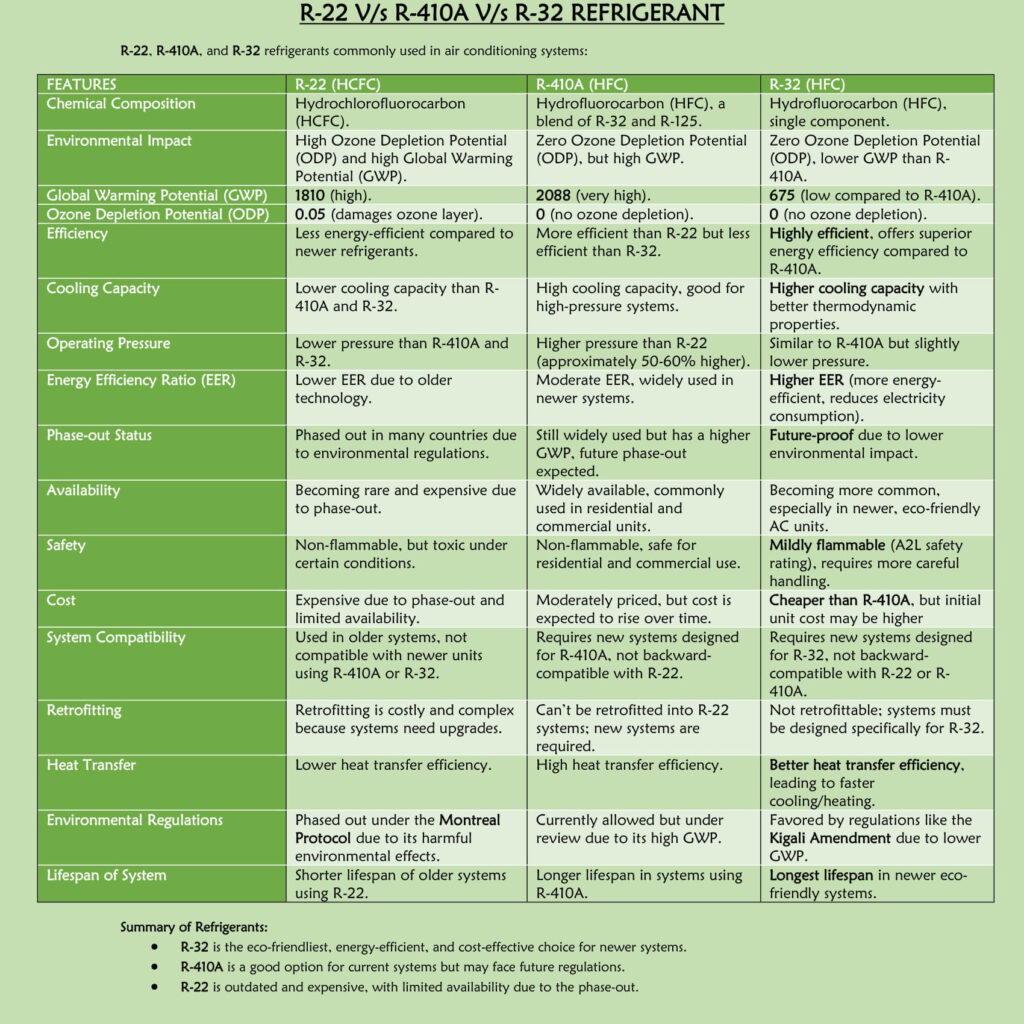
R-22, R-410A, and R-32 refrigerants commonly used in air conditioning systems:
| FEATURES | R-22 (HCFC) | R-410A (HFC) | R-32 (HFC) |
| Chemical Composition | Hydrochlorofluorocarbon (HCFC). | Hydrofluorocarbon (HFC), a blend of R-32 and R-125. | Hydrofluorocarbon (HFC), single component. |
| Environmental Impact | High Ozone Depletion Potential (ODP) and high Global Warming Potential (GWP). | Zero Ozone Depletion Potential (ODP), but high GWP. | Zero Ozone Depletion Potential (ODP), lower GWP than R-410A. |
| Global Warming Potential (GWP) | 1810 (high). | 2088 (very high). | 675 (low compared to R-410A). |
| Ozone Depletion Potential (ODP) | 0.05 (damages ozone layer). | 0 (no ozone depletion). | 0 (no ozone depletion). |
| Efficiency | Less energy-efficient compared to newer refrigerants. | More efficient than R-22 but less efficient than R-32. | Highly efficient, offers superior energy efficiency compared to R-410A. |
| Cooling Capacity | Lower cooling capacity than R-410A and R-32. | High cooling capacity, good for high-pressure systems. | Higher cooling capacity with better thermodynamic properties. |
| Operating Pressure | Lower pressure than R-410A and R-32. | Higher pressure than R-22 (approximately 50-60% higher). | Similar to R-410A but slightly lower pressure. |
| Energy Efficiency Ratio (EER) | Lower EER due to older technology. | Moderate EER, widely used in newer systems. | Higher EER (more energy-efficient, reduces electricity consumption). |
| Phase-out Status | Phased out in many countries due to environmental regulations. | Still widely used but has a higher GWP, future phase-out expected. | Future-proof due to lower environmental impact. |
| Availability | Becoming rare and expensive due to phase-out. | Widely available, commonly used in residential and commercial units. | Becoming more common, especially in newer, eco-friendly AC units. |
| Safety | Non-flammable, but toxic under certain conditions. | Non-flammable, safe for residential and commercial use. | Mildly flammable (A2L safety rating), requires more careful handling. |
| Cost | Expensive due to phase-out and limited availability. | Moderately priced, but cost is expected to rise over time. | Cheaper than R-410A, but initial unit cost may be higher |
| System Compatibility | Used in older systems, not compatible with newer units using R-410A or R-32. | Requires new systems designed for R-410A, not backward-compatible with R-22. | Requires new systems designed for R-32, not backward-compatible with R-22 or R-410A. |
| Retrofitting | Retrofitting is costly and complex because systems need upgrades. | Can’t be retrofitted into R-22 systems; new systems are required. | Not retrofittable; systems must be designed specifically for R-32. |
| Heat Transfer | Lower heat transfer efficiency. | High heat transfer efficiency. | Better heat transfer efficiency, leading to faster cooling/heating. |
| Environmental Regulations | Phased out under the Montreal Protocol due to its harmful environmental effects. | Currently allowed but under review due to its high GWP. | Favored by regulations like the Kigali Amendment due to lower GWP. |
| Lifespan of System | Shorter lifespan of older systems using R-22. | Longer lifespan in systems using R-410A. | Longest lifespan in newer eco-friendly systems. |
Summary of Refrigerants:
- R-32 is the eco-friendliest, energy-efficient, and cost-effective choice for newer systems.
- R-410A is a good option for current systems but may face future regulations.
- R-22 is outdated and expensive, with limited availability due to the phase-out.
